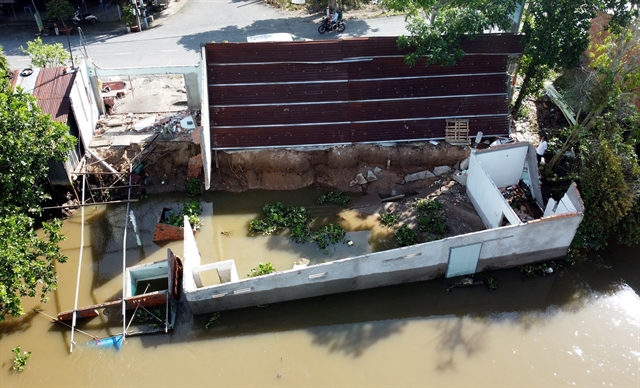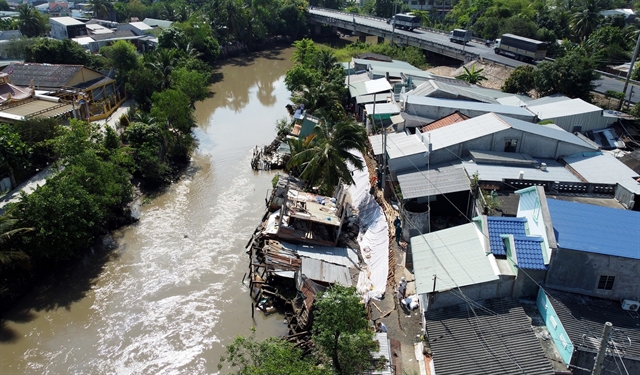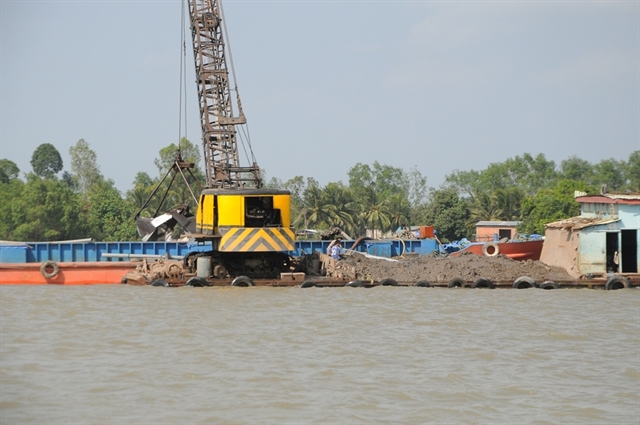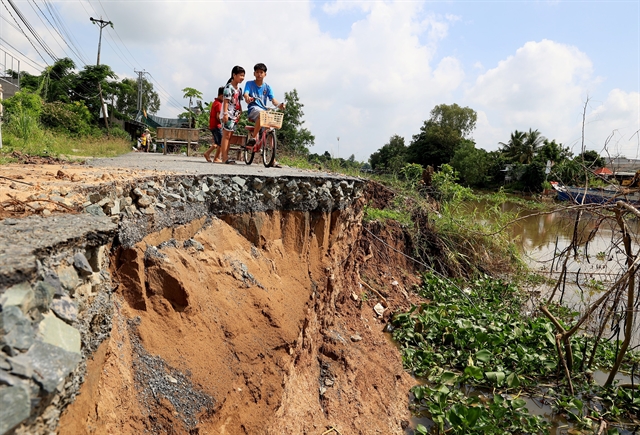 Society
Society


|
| Destructive erosion in Tân Nhuận Đông Commune, Cao Lãnh District, Đồng Tháp Province in mid-June this year. — VNA/VNS Photo Nhựt An |
Hồng Đạt - Thanh Liêm - Nhựt An *
According to experts and officials, human intervention such as excessive sand mining and the construction of hydropower dams that trap sediment from travelling downstream are primary factors contributing to rampant coastal and riverbank erosion in Việt Nam’s Mekong Delta region.
Nguyễn Văn Tiến, Deputy General Director of the General Department of Natural Disaster Prevention and Control said that erosion has been occurring with alarming severity.
He noted that this is a complicated matter, and knowledge of the specific conditions of rivers is needed to identify the causes of erosion. Tiến said that adequate research and documentation are necessary for each river and coastal section.
He noted that: "Sand mining and storage, as well as hydroelectric dams, lead to the loss of the natural balance of sand and are major causes of current erosion in both riverbank and coastal areas.”
Deputy Director of Đồng Tháp Province’s Department of Agriculture and Rural Development Võ Thành Ngoan said that the main cause of erosion in the area is the dynamics of the flow affecting the river bed's soft geological structure.
At the same time, rising sand dunes in the river bed also cause a change in the flow, leading to erosion.
Other factors include human activities like aquaculture and house construction and the impacts of climate change like rainfall fluctuations.
Nguyễn Hữu Thiện, an independent researcher, said the low-lying topographical features of the Mekong Delta region create more risk of erosion, especially during high tide in the coastal area, and heavy rainfall and in the wet season.

|
| Households on riverbanks are vulnerable to landslides from erosion. — VNA/VNS Photo Nhựt An |
Diminishing sediment and sand triggered by illegal mining
Once a large source of sand, many areas in the Mekong Delta are now facing a critical shortage due to illegal mining that exhausts resources and destroys natural habitats in rivers.
Erosion on the banks of the Tiền and Hậu rivers in the Mekong Delta region has increased in both frequency and scale. A survey of sections of Tiền River using the high-resolution shallow seismic method showed that its riverbed topography in has changed significantly in depth and material composition due to strong human impacts, mainly from riverbed sand mining.
Sand mining creates deep holes, changing the direction of riverbed flow and creating large whirlpools. This has a huge impact on the two sides of the river bank.
Overexploitation of river sand also leads to loss of riparian and aquatic habitats, destruction of local flora and fauna, and loss of habitat and cover for river beds. Mining sand directly from a riverbed also affects the density of fish and invertebrate populations. The noise and vibrations of heavy industrial equipment during sand mining can also drive away wild animals close to the river.
Researcher Thiện said the Mekong Delta used to carry massive amounts of sediment and sand downstream. However, from 1992 onwards the amount has been decreasing while landslides have been on the rise.
The main reason is imbalances throughout the river system triggered by a lack of sand and sediment. It is also due to hydroelectric dams that block the flow of sediment downstream (Việt Nam’s Mekong Delta region is downstream of the Mekong River) and sand mining on the Mekong in all countries including Thailand, Laos, Cambodia and Việt Nam.
According to Hà Huy Anh, Project Manager of Sustainable Sand Management in the Mekong Delta of the World Wide Fund for Nature (WWF) in Việt Nam, the Mekong Delta is suffering a net loss of between 27.5 to 39.5 million tonnes of sand each year.
A survey of the project showed that the amount of sand recorded in Tân Châu Town (in An Giang Province), considered the largest sand mine in the Mekong Delta, is currently about 15 to 20 per cent of the amount of sand poured into the Delta 30 years ago.
River sand has long been classified as a common construction material under the 2010 Mineral Law. Sand mining conducted in a locality must be approved by the People's Committee of that locality.
However, illegal sand mining in the Mekong Delta region still occurs due to the increasing demand, even though the licensing of mining is limited. This is an alarming trend, contributing to the serious landslides that have been taking place throughout the region.
According to Đặng Trọng Hải from the Centre for Environmental Information and Data (under the Vietnam Environment Administration ), river sand mining is increasingly common in the Mekong Delta.

|
| Sand is dredged in a river in the Mekong Delta region. — Photo kinhtedothi.vn |
Currently, there are 82 companies licensed to exploit 28 million tonnes of river sand per year. However, the reported amount of sand and the actual amount of sand extracted is difficult to control and illegal mining is still common.
The Ministry of Construction has warned that Việt Nam’s natural sand and gravel resources may be exhausted in the next 10 years.
The increasing demand for construction materials and levelling sand lead to illegal mining in many localities. The violators use many methods to bypass the authorities including exploiting at night or early in the morning, even organising night watches to notify each other when the authorities arrive.
In addition, many licensed firms fail to comply with the provisions of the granted license, including terms, mining capacity and locations.

|
| A landslide 50 metre long and 5-7 metres wide occurs in Cao Lãnh District, Đồng Tháp Province. — VNA/VNS Photo Hồng Đạt |
Đồng Tháp Province’s police stopped 20 cases of illegal mining with total fines of VNĐ550 million since 2022.
Hoàng Việt, Director of the project, said that although current sand mining activities are not sustainable, it is not feasible to stop sand mining immediately. Therefore, it is necessary to build a "sand budget".
The calculation of the resources needed will provide policymakers with an understanding of the amount of sand that can be exploited and the location of mining without causing negative impacts, he said. — VNS
* This is part of a four-episode series by Vietnam News Agency reporters on erosion in the Mekong Delta region.




